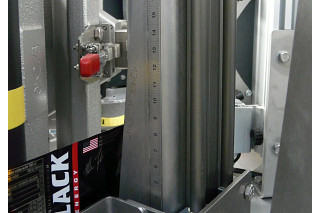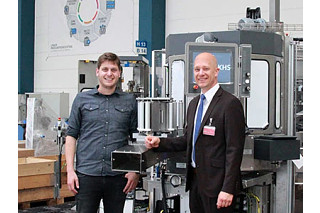Change Language :
Adjusted quickly – precisely mounted
igus® as module supplier for KHS labelling machines
Numerous rotary and linear bearings from the igus® product range are not the only ones installed in KHS GmbH's labelling machines. igus® also supplies complete, ready-to-install modules such as adjustment systems and guide rollers, etc. From the KHS's point of view, this not only simplifies assembly. It also ensures high-precision, high-speed working sequences.
60,000 bottles per hour or 1,000 bottles per minute and just under 17 every second: this is the output of a typical beverage filling and packing plant from KHS. This company, which is headquartered in Dortmund, is one of the market leaders worldwide developing, designing and building such systems – turnkey on request. KHS has a headcount of around 5,000, generated sales of around €1.18 billion in 2016 and is a wholly-owned subsidiary of the Salzgitter Group.
The distribution of sales in the Labelling Division shows the impressive international presence of the company: More than 80 percent is generated outside of Europe.
Core competence – Labelling technology

The Innoket Neo module for bottling plants labels up to 60,000 bottles per hour – in a compact space and with high precision.
Labelling technology has traditionally been one of the core competencies of KHS. From the point of view of the customer, the label – just like the bottle design – is becoming more and more important because there is great competition on the beverage market and consumers take only a few seconds to decide for one or the other product. Cornelius Adolf, Product Manager for KHS labelling technology: "With the label, beverage manufacturers can generate attention and stand out positively. This has a direct promotional effect on sales. “
High-speed: 300 labels in 20 seconds
KHS offers bottlers labelling stations for different technologies (hot glue, cold glue, rolled or self-adhesive). One of the latest developments in the "Innoket Neo" modular system is the roll-fed station, which replaced the predecessor Innoket 360S at the end of 2016. Roll-fed means: The wrap-around labels are unwound from a roll, cut to the correct length in the cutting unit and glued using a roller. Then they are applied to the bottle. The bottle rotates during delivery of the label, which is directly brushed down. A typical feature of this technology is the "autosplicer", which glues the two label rolls seamlessly, thus ensuring uninterrupted operation of the machine.
The entire process takes place at a breathtaking speed. In the 20 seconds or so you took to read the previous paragraph, the Innoket Neo RF would have labelled more than 300 bottles. This places high demands on all movable components, in particular also on their precision.
Ready-to-install components instead of single parts
The strategy of KHS can be seen in this context: In the case of new developments in labelling technology, modules and systems for individual functions – for example, horizontal adjustment units or guide rollers – are increasingly purchased as ready-to-install components.
Here, a whole series of requirements must be met. Cornelius Adolf: "During bottling it is, as a matter of fact, always wet or at least damp. For this reason, the components must be very resistant to corrosion and common cleaning media. High wear resistance and hygiene are at least just as important. Lubrication-free components help to avoid contamination – especially when empty, open bottles are being labelled. “
Deflection and adjustment systems as ready-to-install components

igus® provides the sensor adjustment for the cutting mark detection of the label as a ready-to-install module. The basis is a drylin® W linear guide.
This feature profile fits in with igus®'s bearing technology, which has also been used in various KHS systems for around twenty years. This applies to both the rotary iglidur® bearings bushes and the drylin® linear technology. What is new, however, is that igus® not only supplies the bearings, but also completely ready-to-install functional components.
In the roll-fed station of the Innoket Neo there are numerous examples to be seen – in the height adjustment of the cutting mark sensor. Cornelius Adolf: "So far, we have always assembled this function ourselves from numerous parts. Now we are completely covered by igus®: with linear adjustment unit, clamping, measuring scale and fixing for assembly. The basis is a drylin W linear guide of the type WS-10-40.
The guide rollers for the label guidance through the roll-fed station are a second example. The rollers – which are, of course, also lubrication-free and corrosion-resistant – are equipped with xiros® polymer ball bearings. The roller material was selected in practical tests such that the exact desired frictional resistance is met.
Higher precision through standardisation
The horizontal adjustment unit of the entire work table is a further complete system. It helps to adjust the distance of the roll-fed station to the basic machine. The adjustment is performed by a handle using a lead screw. The rear guidance was designed using drylin® W linear guides of the type WSQ-16. And since the labelling station is mobile, an energy chain from the igus® product range takes over the flexible supply of energy, signals, vacuum and compressed air.
High flexibility, reproducible labelling performance

From left to right: Cornelius Adolf, Product Manager Labelling Technology at KHS, Florian Blömker, Technical Sales Consultant at igus®.
Cornelius Adolf: "Many users move disposable and reusable bottles along one and the same line and therefore require two different label types on one machine. The changeover time is therefore an important criterion, as is a fast format change depending on bottle and label sizes. " The igus® components help to meet these requirements economically and with high reproducibility. The latter is always a decisive factor for beverage manufacturers with full flexibility. Cornelius Adolf: "Even if 60,000 bottles are labelled per hour, one bottle must look exactly like the other. " The functional systems and components from igus also make an important contribution to obtaining this result.
null




